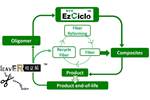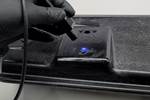University of Southern Queensland project to create new class of epoxy resins
Project leader Dr. Siqi Huo awarded more than $421,000 through the Australian Research Council to create single-component epoxy resins with improved storage stability, fire retardancy, mechanical properties.

Dr. Siqi Huo. Photo Credit: Univerisy of Southern Queensland
Addressing the issue of epoxy resin’s flammability and relatively short shelf life is a (Australia) research project recently funded through the ARC Discovery Early Career Researcher Award (DECRA) program. More than $421,000 has been awarded to the project, led by Dr. Siqi Huo, to create a new class of phosphorus/imidazole oligomers for single-component epoxy resins with improved storage stability, fire retardancy and mechanical properties.
“As one of the most important polymers, epoxy resin features high mechanical strength, outstanding adhesion, chemical resistance and good electrical insulation,” Dr. Huo says. “Due to these features, it is used extensively in construction, automotive, electronics and aerospace industries.”
Compared with two-component epoxy resins, one-component systems are a premix with a latent curing agent to reduce the problems of on-site weighing, mixing and defoaming, which makes it easier and more economical to use. According to Dr. Huo, this enables lower pollution, reduced in-mold time and increased production efficiency, making one-component epoxy resins preferable for mass production and high-tech industry applications.
“Imidazoles are currently one of the most promising latent hardeners, but they can cure the epoxy resin at room temperature for a short time, leading to poor storage stability and short shelf life,” Dr. Huo continues. “Meanwhile, existing phosphorus-containing imidazole latent curing agents suffer from unsatisfactory fire retardancy. This project will overcome these weaknesses to develop environmentally benign, flame-retardant oligomers that will reduce fire hazards, protecting lives, property and the environment, by replacing current flammable epoxy resins commonly used.”
Dr. Huo, a researcher focused on phosphorus-based flame retardants and fire-safe polymer composites, is currently employed as a full-time postdoctoral research fellow at Zhejiang University in China. He will join University of Southern Queensland from 2023.
Related Content
-
Plant tour: Collins Aerospace, Riverside, Calif., U.S. and Almere, Netherlands
Composite Tier 1’s long history, acquisition of stamped parts pioneer Dutch Thermoplastic Components, advances roadmap for growth in thermoplastic composite parts.
-
Plant tour: Teijin Carbon America Inc., Greenwood, S.C., U.S.
In 2018, Teijin broke ground on a facility that is reportedly the largest capacity carbon fiber line currently in existence. The line has been fully functional for nearly two years and has plenty of room for expansion.
-
Revisiting the OceanGate Titan disaster
A year has passed since the tragic loss of the Titan submersible that claimed the lives of five people. What lessons have been learned from the disaster?






